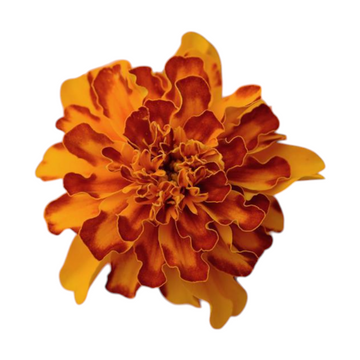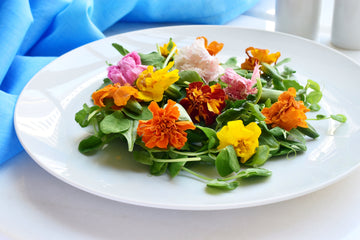Marigold Bonanza Bolerno

Freshly Harvested

Non-GMO & Natural

Nutrient Dense

Trusted by Chefs
25 Seeds+
🌼 Marigold ‘Bonanza Bolero’ Edible Flower Seeds
Tagetes patula
A carnival of color 🎭🔥, Marigold ‘Bonanza Bolero’ explodes with double-layered petals in deep red and golden yellow. Compact and free-blooming, this French marigold is as striking in the garden as it is on the plate. Long celebrated in global cuisines, marigold petals bring peppery, citrusy brightness 🌶️🍊 and are often called “poor man’s saffron” for their ability to tint and flavor dishes. Hardy, pest-resistant, and pollinator-friendly 🐝🌿 — a true multitasker for chefs and growers alike.
👅 Flavor Profile:
Peppery 🌶️, tangy citrus 🍊, with earthy saffron-like undertones 🌿.
🍴 Culinary Uses:
🥗 Sprinkle petals over salads for fiery color + bite
🥘 Infuse petals into rice, stews, or curries as a saffron substitute
🍸 Float petals in cocktails, syrups, or shrubs for citrus-floral notes
🧁 Garnish cakes, breads & desserts with bold golden-red accents
🍵 Brew into teas or herbal blends for a peppery-citrus kick
👨🍳 Chef’s Pitch:
Marigold ‘Bonanza Bolero’ is the edible flower that demands attention 🌼👨🍳✨. With its dramatic red-and-gold blooms and sharp, citrusy flavor, it transforms simple dishes into vibrant chef creations. Used historically as a natural dye and flavor enhancer, it remains a favorite for gourmet plating, festive cocktails, and global-inspired cuisine.
🌱 Growing Notes:
🪴 Compact, bushy annual — 8–12” tall, great for borders & containers
🌼 Blooms continuously summer–frost, heavy flower set
🌞 Thrives in full sun, easy to grow & low-maintenance
🐝 Attracts pollinators + repels garden pests (natural companion plant)
🔄 Excellent cut-and-come-again bloomer
✨ Quick Facts:
-
Latin Name: Tagetes patula (‘Bonanza Bolero’)
-
Habit: Annual, compact 8–12” tall
-
Flavor: Peppery, tangy, saffron-like
-
Culinary Uses: Salads, teas, cocktails, rice, desserts
-
Companion Planting: Repels nematodes & aphids, attracts bees 🐝

Marigold Bonanza Bolerno

Let’s Manifest Beauty.
Edible Flowers that Smile.
Edible flowers are more than just decoration — they’re a chef’s secret for adding elegance, fragrance, and subtle flavor to a dish. From citrusy marigolds to honey-sweet alyssum and tangy begonias, these delicate blooms transform plates into experiences. Each petal offers color, aroma, and taste, turning simple ingredients into a culinary statement.

Flowers are here to stay
The Art of Garnishing with Edible Flowers
A garnish should do more than decorate — it should enhance. Edible flowers bring color, fragrance, and subtle flavor to the plate, turning simple dishes into memorable experiences. From delicate petals scattered across a salad to a single bloom crowning a dessert, flowers add elegance and elevate presentation in ways that engage every sense.
The Secret Ingredient Chefs Trust
Widely used in professional kitchens, microgreens enhance flavor profiles while adding nutrition and a striking visual appeal to everything from sandwiches to fine dining creations.
Frequent Asked Questions
Q: What are Microgreens?
Microgreens are young, tender plants harvested just after the first leaves develop. They’re packed with flavor, color, and nutrients, making them both delicious and healthy.
Q: Are microgreens really more nutritious than regular vegetables?
Yes. Research shows that microgreens can contain up to 40x more vitamins and antioxidants (like A, C, K, and E) compared to their mature counterparts.
Q: How do I use microgreens in my meals?
They’re incredibly versatile—use them as a garnish, in salads, on sandwiches, in wraps, smoothies, soups, or even as a centerpiece ingredient in gourmet dishes.
Q: How long do microgreens stay fresh?
Stored properly in a fridge, microgreens typically last 5–7 days. To keep them at peak freshness, store them dry in a breathable container.









